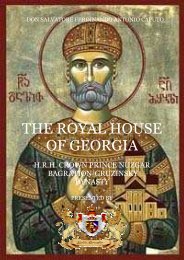here - Nobility Associations
here - Nobility Associations
here - Nobility Associations
You also want an ePaper? Increase the reach of your titles
YUMPU automatically turns print PDFs into web optimized ePapers that Google loves.
According to Jerónimo Zurita 6 , including those who first had<br />
made contact with Peter t<strong>here</strong> was Corrado of Antioch, cousin to<br />
his wife Constance. The Author writes, which refers to the year<br />
1281 “los principals que persuadian al Rey don Pedro a esto<br />
eran el Marqués de Monferrato, el conte Guido Novello,<br />
Corrado de Antiochia nieto del Emperador Federico, que estava<br />
casado con hija del Conde Galvan, y el Conte Guido de<br />
Montefieltro” (G. Surita, op. Cit, I, page 237)<br />
At the beginning of the following year Francesco Troisio, who was also an exile and<br />
a great friend of Corrado of Antioch, delivered a few letters of credentials to Peter<br />
Aragon on behalf of Corrado, the Marquis of Monteferrato and other Ghibellines of<br />
the Kingdom (M. Amari, op. Cit page 164 n. 8). The letters contained explicitly<br />
promises of help from everyone to Peter of Aragon to demand their rights to the<br />
kingdom and warm invitations to take immediate steps.<br />
The king of Aragon welcomed with great satisfaction of both the invitations and<br />
offers of help. This can be seen in the letter that shortly after he wrote to the king of<br />
Castile who reported having received “litteras de credencia nobelium virorum<br />
Montisferrati, comitis Guidoni Novelli, illustris Corradi de Antiochia, nostrorum<br />
dilectorum affinium, comitis Guidonis de Montefeltro et aliorum comitum et<br />
magnatum Italie ac Regni Sicilie recipimus per nobilem latorem presentium<br />
Franciscum Trogisii cuius legationem magestati vestre non expriminus litteris<br />
istis, cum idem nuncius eamdem veniat relaturus, quem benigne audiat<br />
excellentia vestra si placet et super capitulo illo precipue scilicet super<br />
recuperatione regni Sicilie, ad quod vestrum auxilium gratuita volante nobis per<br />
dilectum scutiferum nostrum Andream de Proxida liberaliter obtulisti” (The letter<br />
was published by A. Saint-Priest, Histoire de la Conquéte de Naples par Chales<br />
d´Anjou, Paris, 1847, 4, page 205, of Amari, op. cit., II, page 251, in part from<br />
Ridola, op. cit., page 249 n.2 and I. Carini, Archives and Libraries of Spain,<br />
Palermo, 1884, page 45).<br />
From Africa the Aragonese and his fleet king deviated to Sicily on August 30, 1282<br />
and disembarked in Trapani acclaimed by the crowd. Then he continued with the<br />
fleet on to Messina defeated the French. With the arrival of Peter and of his fleet,<br />
the position became untenable for Charles. On September 26 Charles d´Anjou<br />
abandoned the siege of Messina and went to Calabria. Meanwhile, Peter of Aragon<br />
had received in Palermo the crown of King of Sicily. (F. Gregorovius, op. cit., III,<br />
page 75).<br />
6 Jerónimo (or Gerónimo) de Zurita y Castro (1512 – 3 November 1580) was an Aragonese historian<br />
of the sixteenth century who founded the modern tradition of historical scholarship in Spain.<br />
The Hohenstaufen Dynasty - Page 161 of 200



